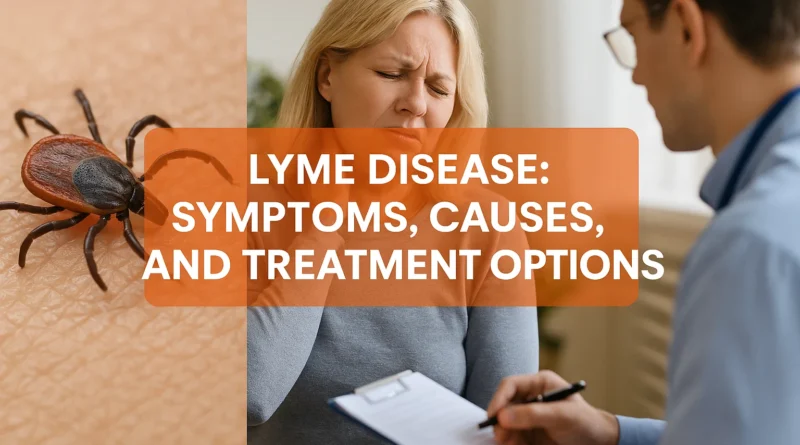Lyme Disease: Symptoms, Causes, and Treatment Options
The prevalence of Lyme disease has increased worldwide, making it a concern. It is caused by the bacterium Borrelia, which is transmitted during a tick bite and can affect the nervous system, joints, heart, and skin if left untreated. Because the early signs resemble flu-like symptoms, it is often misdiagnosed and left untreated, which can make the condition worse.
This article helps you to understand the symptoms, causes, and risk factors essential for early treatment and diagnosis that help in proper recovery.
What is Lyme Disease?
It is a bacterial infection transmitted through the bite of Ixodes ticks, also known as black-legged ticks (or deer ticks), which harbor the bacteria Borrelia. Not all ticks carry the bacterium, but those found in endemic regions, such as North America, Europe, and parts of Asia, pose a risk. While anyone can get Lyme disease, the person travelling in these regions, especially in grassy and wooded areas, has an increased risk of getting Lyme disease.
Early treatment is essential because if the disease progresses to a severe stage, it can lead to neurological problems: heart rhythm issues and chronic joint pain. Early diagnosis makes it highly treatable with antibiotics.
What causes Lyme Disease?
Borrelia burgdorferi is one of the direct causes of Lyme disease infection, which is spread through a tick bite and enters the bloodstream. Here is the breakdown:
Tick bite and Infection: As the tick bites, the infection transfers through the skin into the bloodstream.
Transmission of Bacteria: For an infection to be transmitted and spread, a tick needs to be attached for at least 24-48 hours. Quick removal of the tick lowers the risk.
Geographical exposure: These ticks are mostly prevalent in the US, along with Europe, and some parts of Asia. Blacklegged ticks, also known as deer ticks, act as the primary vector and transmit bacteria responsible for Lyme disease.
What are Lyme Disease Symptoms and Stages?
Depending on the stage of infection, symptoms may appear in the early or later phase of the disease; These include
Early-Stage Symptoms
- Localized Stage
As soon as the tick bites, a skin rash develops around the bite, known as Erythema migrans(EM rash) or bull’s-eye, which is the hallmark sign that indicates EM rash. It may not be itchy or painful, but it comes with symptoms such as
- Chilling Fever
- Fatigue
- Headaches and muscle aches
- Swollen lymph nodes (often mistaken for viral infection)
Late-Stage Symptoms
2nd stage of Lyme disease (weeks to months)
As symptoms worsen, multiple EM rashes appear all over the body. Some of the late-stage symptoms that appear include
- Facial Palsy (a neurological condition that causes drooping on one side of the face)
- Irregular heartbeat (due to improper nerve conduction)
- Shooting Pain, Numbness, or tingling in the feet
- Migratory joint pain with stiffness.
Late-Stage Lyme Disease (months-year)
This is because when Lyme disease is left untreated for a longer period of time, which may be due to less awareness or late diagnosis, it can lead to
- Long-term Swelling affecting the large joints, like the knee, is a sign of arthritis.
- Neurological issues like sleep disturbances, memory loss,
- Chronic fatigue and difficult concentrating (brain fog)
Advice: A doctor’s consultation is required if you are having these symptoms; early diagnosis is key to detecting this disease at an early stage and ensuring a quick recovery.
How to Diagnose Lyme Disease?
Diagnosis of Lyme disease starts with a Physical examination, where the doctor will look for symptoms, such as a rash or any other signs; they will look for your travel history. Tick exposure history for a more thorough analysis.
Based on this, your doctor will recommend the blood tests specifically to look for and check whether the disease persists.
Lab Test for Lyme Disease
ELISA (Enzyme-Linked Immunosorbent Assay) is used as the first screening test to detect Lyme disease, which checks for antibodies against the bacteria. If the ELISA test comes back positive or borderline, a Western blot is done to confirm the diagnosis by identifying specific antibodies.
What are the Treatment options for Lyme Disease?
Early treatment is possible with the antibiotics that ensure full recovery. It is recommended to discuss with your doctor before taking this treatment.
Antibiotic Therapy (first-line treatment)
Oral antibiotics (10-21 days): antibiotics like Doxycycline (for adults and children over 8 years old). Amoxicillin (for younger children and pregnant women) and Cefuroxime Axetil (for penicillin allergies).
Intravenous antibiotics (2–4 weeks):
Used in severe cases involving neurological or cardiac complications.
2. Symptom Management
- Anti-inflammatory medicines for joint pain.
- Physical therapy to treat muscle and joint stiffness.
- Rest and hydration to aid recovery.
3. Chronic Lyme Disease or Post-Treatment Lyme Disease Syndrome (PTLDS)
Even after treatment, some people continue to experience symptoms like fatigue, pain, and cognitive issues. This condition, also known as PTLDS, is caused by immune-related damage rather than an active infection. Management usually involves:
- Pain reliever medications.
- Rehabilitation exercises.
- Supportive therapy to treat long-term symptoms.
How to Prevent Lyme Disease?
Since there is no vaccine available, prevention focuses on avoiding tick exposure. This can be done by
- Wearing a full-sleeve shirt and full-length pants in high-risk areas
- Use Insect repellents wherever necessary
- Check for ticks on your body when coming from an outdoor activity
- To get rid of ticks, keep your yard free from tall grass.
What should I do if a tick bites?
Don’t panic; all you need to do is remove the tick by following these ways
- Using fine-tipped tweezers, remove the tick. Grasp the tick as close to the skin as possible and pull it up with consistent, even pressure. Do not twist or jerk it.
- Wash the site and your hands with soap and water. Rubbing alcohol or iodine can be used to disinfect the site.
- Check for a fever or rash (especially a bull’s-eye rash) that appears along with other symptoms such as joint pain, fatigue, or flu-like symptoms.
- If you live in an area where Lyme disease is prevalent, consult a doctor; they may recommend a blood test or prescribe antibiotics as needed.
- Don’t try to burn the tick, apply oil, or squeeze it. These activities can make the tick release more infectious material into your skin.
When to Seek a Doctor’s Help
Consult a doctor if you:
- Get flu-like symptoms or a rash after being bitten by a tick.
- Observe neurological conditions such as severe headaches or facial drooping.
- Having persistent fatigue, joint pain, or irregular heartbeat after tick exposure.
Final Thoughts
Lyme disease is often overlooked, but if not treated, it can cause serious health issues. Detecting symptoms early, especially the characteristic bull’s-eye rash, and getting proper medical care can help prevent complications. You can protect yourself and your loved ones from the long-term effects of Lyme disease by taking preventive steps, staying aware of ticks, and seeking treatment early.
Frequently Asked Questions
What are the five early signs of Lyme disease?
Early signs include
- Fever or chills
- Headache
- Muscle and joint aches
- Fatigue (feeling very tired)
It’s important to note these signs and get doctor help as soon as possible if symptoms last for more than 2 weeks.
Who is at higher risk of getting Lyme Disease?.
- Travelling in an area where deer ticks are common
- Outdoor activities in wooded or grassy environments.
- Not using insect repellents or full-coverage clothing.
- Not doing a self-check after outdoor activity for ticks.
Does Lyme Disease Spread from Person to Person?
No, it doesn’t spread from person to person; you cannot catch it from touching, kissing, or sharing food with the person infected with Lyme disease.
Where is Lyme disease most common?
Commonly found in the U.S., Europe, and parts of Asia. In India, cases are rare but possible in forested or hilly regions where ticks are found.
Is Lyme disease similar to flu symptoms?
Yes. Unlike the flu, early Lyme symptoms can feel similar, but they last longer and, if left untreated for a long time, can develop into joint pain, nerve problems, or heart problems.
Can Lyme disease be cured?
Yes, if diagnosed and detected early, most cases can be successfully treated with antibiotics. Consult with your doctor if you are having any symptoms of Lyme disease.




